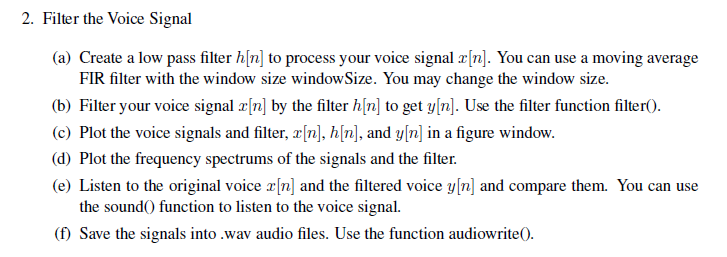Answered step by step
Verified Expert Solution
Question
1 Approved Answer
Suppose that we have audio signal x[n]. 2. Filter the Voice Signal (a) Create a low pass filter h[n] to process your voice signal x[n].

Suppose that we have audio signal x[n].
2. Filter the Voice Signal (a) Create a low pass filter h[n] to process your voice signal x[n]. You can use a moving average FIR filter with the window size windowSize. You may change the window size. (b) Filter your voice signal x[n] by the filter h[n] to get y[n]. Use the filter function filter(). (c) Plot the voice signals and filter, x[n], h[n], and y[n] in a figure window. (d) Plot the frequency spectrums of the signals and the filter. (e) Listen to the original voice x[n] and the filtered voice y[n] and compare them. You can use the sound() function to listen to the voice signal. (f) Save the signals into .wav audio files. Use the function audiowrite(). 2. Filter the Voice Signal (a) Create a low pass filter h[n] to process your voice signal x[n]. You can use a moving average FIR filter with the window size windowSize. You may change the window size. (b) Filter your voice signal x[n] by the filter h[n] to get y[n]. Use the filter function filter(). (c) Plot the voice signals and filter, x[n], h[n], and y[n] in a figure window. (d) Plot the frequency spectrums of the signals and the filter. (e) Listen to the original voice x[n] and the filtered voice y[n] and compare them. You can use the sound() function to listen to the voice signal. (f) Save the signals into .wav audio files. Use the function audiowrite()Step by Step Solution
There are 3 Steps involved in it
Step: 1

Get Instant Access to Expert-Tailored Solutions
See step-by-step solutions with expert insights and AI powered tools for academic success
Step: 2

Step: 3

Ace Your Homework with AI
Get the answers you need in no time with our AI-driven, step-by-step assistance
Get Started


